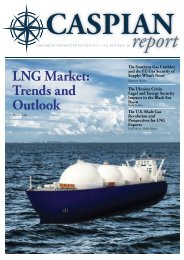Caspian Report - Issue: 07 - Spring 2014
You also want an ePaper? Increase the reach of your titles
YUMPU automatically turns print PDFs into web optimized ePapers that Google loves.
The Southern Gas Corridor has been<br />
described as the successful outcome of the<br />
EU’s quest to diversify supplies and wean<br />
itself off Russian gas, a priority of its energy<br />
security strategy.<br />
The Southern Gas Corridor (SGC) – a<br />
3,500 km route that in its first stage<br />
will facilitate the transport of 10<br />
bcm/year of <strong>Caspian</strong> gas to Southern<br />
Europe by the end of the decade - has<br />
been described as the successful outcome<br />
of the EU’s quest to diversify<br />
supplies and wean itself off Russian<br />
gas, a priority of its energy security<br />
strategy.<br />
Nevertheless, such a description is<br />
somewhat simplistic. Firstly, it gives<br />
the false impression that energy<br />
security can be achieved simply by<br />
replacing one molecule of gas with<br />
another of different geographical<br />
origin, without emphasising that it is<br />
the diversity of norms and practices<br />
underpinning contractual agreements<br />
between buyers and sellers<br />
that offers greater choice, and implicitly<br />
greater flexibility, rather than<br />
merely swapping the products.<br />
Secondly, diversity of supply is not<br />
itself a guarantor of energy security,<br />
as demonstrated by the case of the<br />
US, which relies almost entirely on<br />
nationally produced gas. In Europe,<br />
where consumption is projected to<br />
increase to 550 bcm/year in 2020<br />
from 490 bcm/year in 2012, there<br />
is admittedly a need for more gas<br />
to plug the shortfall. In this context,<br />
multiple sources of supply can<br />
ensure greater security, providing<br />
they are physically deliverable, commercially<br />
attractive and politically<br />
invulnerable. 1<br />
This article proposes to assess the<br />
viability of the SGC against these<br />
three benchmarks, noting that despite<br />
its rather limited dimensions<br />
compared to Europe’s other sources<br />
of supply – notably Russian and Norwegian<br />
pipeline gas as well as the<br />
potential for increased LNG imports<br />
– the project could bring greater economic<br />
efficiency throughout the<br />
continent, help to integrate the EU’s<br />
more vulnerable south eastern region<br />
and establish itself as a link between<br />
east and west.<br />
The discussion will show that in<br />
the light of recent political tensions<br />
between Europe and Russia over<br />
Ukraine, there is also a pessimistic<br />
obverse to this scenario whereby the<br />
33<br />
CASPIAN REPORT, SPRING <strong>2014</strong><br />
1.<br />
I am grateful to my colleagues Louise Boddy and Ben Wetherall for pointing these out.










